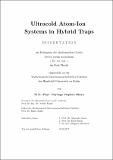| dc.description.abstract | This thesis deals with the theoretical description of a hybrid system of an
ultracold neutral atom and a single ion. These hybrid atom-ion systems have
attracted significant interest in recent years. They combine the key advantages
of ultracold neutral atoms and ions. In particular, neutral atoms are easily
scalable and can be prepared in large numbers, while trapped ions can be stored
for much longer times and are easy to control. Some of the proposed prospects
of the hybrid quantum systems include sympathetic cooling of trapped ions,
ultracold chemistry, quantum information processing, and atom-ion quantum
simulators. These applications require extremely precise control and thus
very accurate theoretical modeling. A new method that allows for a full sixdimensional treatment of two particles in spatially separated three-dimensional
trapping potentials was developed. By allowing for the spatial displacement
between the trapping potentials, it is possible to describe the controlled motion
of a single ion through an optical-lattice potential filled with neutral atoms. The
interaction between the neutral atom and the ion is modeled using realistic BornOppenheimer potential curves from ab initio quantum chemistry calculations.
An application of the developed approach to the hybrid atom-ion system of 7Li+
2
isotope reveals avoided crossings between the molecular bound states and the
unbound trap states as a function of the separation between the two traps. These
avoided crossings correspond to trap-induced resonances. This finding confirms
the trap-induced resonances predicted earlier based on quantum-defect-theory
calculations. Also, the recently found inelastic confinement-induced resonances
in ultracold neutral atoms are demonstrated to be present in atom-ion systems.
These resonances arise due to the coupling between the center-of-mass and
relative motions. The inelastic confinement-induced resonances could be used
in coherent molecular ion formation and in the determination of atom-ion
scattering properties like the scattering lengths. | en_US |

